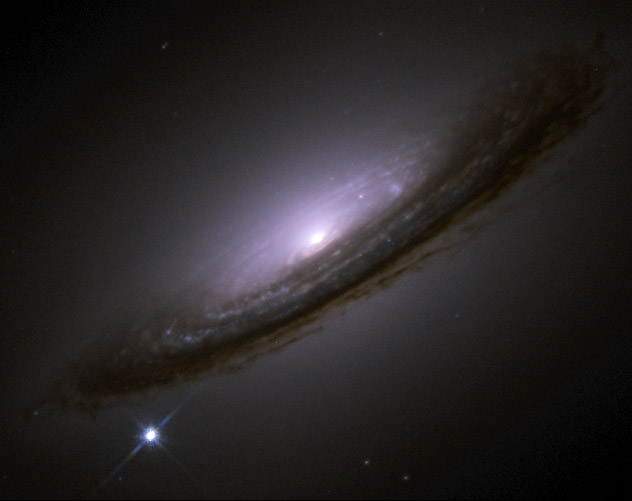[/caption]
What is a supernova? Well, “nova” means “new star”, and “super” means “really big”, like supermarket, so a supernova is a really bright new star. That’s where the word comes from, but today it has a rather more precise meaning, namely a once-off variable star which has a peak brightness similar to, or greater than, that of a typical galaxy.
Supernovae aren’t new stars in the sense that they were not stars before they became supernovae; the progenitor – what the star was before it went supernova – of a supernova is just a star (or a pair of stars), albeit an unusual one.
From what we see – the rise of the intensity of light (and electromagnetic radiation in general) to a peak, its decline; the lines which show up in the spectra (and the ones which don’t), etc – we can classify supernovae into several different types. There are two main types, called Type I and Type II. The difference between them is that Type I supernovae have no lines of hydrogen in their spectra, while Type II ones do.
Centuries of work by astronomers and physicists have given us just two kinds of progenitors: white dwarfs and massive (>8 sols) stars; and just two key physical mechanisms: nuclear detonation and core collapse.
Core collapse supernovae happen when a massive star tries to fuse iron in its core … bad move, because fusing iron requires energy (rather than liberates it), and the core suddenly collapses due to its gravity. A lot of interesting physics happens when such a core collapses, but it either results in a neutron star or a black hole, and a vast amount of energy is produced (most of it in the form of neutrinos!). These supernovae can be of any type, except a sub-type of Type I (called Ia). They also produce the long gamma-ray bursts (GRB).
Detonation is when a white dwarf star undergoes almost simultaneous fusion of carbon or oxygen throughout its entire body (it can do this because a white dwarf has the same temperature throughout, unlike an ordinary star, because its electrons are degenerate). There are at least two ways such a detonation can be triggered: steady accumulation of hydrogen transferred from a close binary companion, or a collision or merger with a neutron star or another white dwarf. These supernovae are all Type Ia.
One other kind of supernova: when two neutron stars merge, or a ~solar mass black hole and a neutron star merge – as a result of loss of orbital energy due to gravitational wave radiation – an intense burst of gamma-rays results, along with a fireball and an afterglow (as the fireball cools). We see such an event as a short GRB, but if we were unlikely enough to be close to such a stellar death, we’d certainly see it as a spectacular supernova!
Would you like to read more about what a supernova is? Check out these webpages: Hubblesite’s News Releases on Supernova, Supernova Cosmology Project (Lawrence Berkeley Lab), and Supernovae, Supernova Remnants (etc) (Talk Origins).
Everyone has a fascination for things which go bang!, and so you won’t be at all surprised to learn that Universe Today has many articles on supernovae, what a supernova is, etc. Here is selection for your enjoyment and education: Merging White Dwarfs Set Off Supernovae, GRB Central Engines Observed in Nearby Supernovae?, and Another Antimatter Supernova Discovered.
Astronomy Cast too has several episodes on what a supernova is; for example We’re All Made of Supernovae, and Gamma-Ray Bursts.
Reference:
NASA

